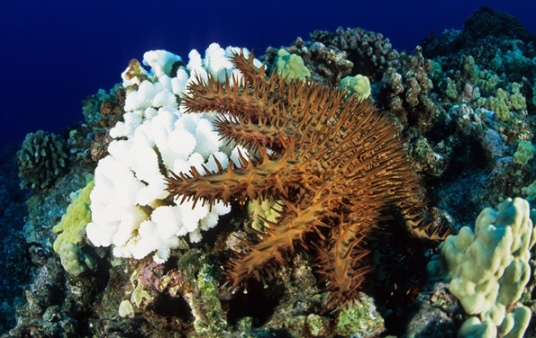Crown-of-thorns starfish or sea stars (Acanthaster planci; order Valvatida) are predatory marine invertebrates that feed on phytoplankton found on coral. They are native inhabitants of coral reefs in both the Indian Ocean and Pacific Ocean and are particularly common on the Great Barrier Reef, which is the largest living structure in the world, covering an area of more than 340,000 km2 (131,000 mi2) off the northeast coast of Australia. Lately, crown-of-thorns sea stars are exploding in numbers, offsetting the ecosystem balance found in the waters of the Great Barrier Reef and causing marine investigators to fear severe degradation of the coral reefs, which are already under pressure from coral bleaching (the response of corals to environmental stress in which they eject the algae that live within the transparent coral tissue, making the white coral skeleton visible) and other effects of rising sea temperatures. See also: Asteroidea; Australia; Coral bleaching; Coral reef complexity; Ecological communities; Ecosystem; Marine ecology; Ocean warming; Reef; Severe coral bleaching endangers Great Barrier Reef; Valvatida

Typically, an individual crown-of-thorns sea star sits on top of the coral, extends its extrudable stomach over the coral, and eats the phytoplankton organisms that live within the coral. Often, though, in the sea star's process of eating the phytoplankton, the tissues of the coral are enzymatically liquefied and digested, destroying the integrity of the coral. Still, under normal conditions, this predatory behavior allows the coral to survive with minimal damage because the numbers of starfish and phytoplankton remain relatively low. However, the phytoplankton in the coral ecosystem can reach dramatically higher numbers when coastal and agricultural runoff (from fertilizers and various pollutants) increases. These increases in runoff—often ascribed to more frequent floods as a result of more severe monsoons and cyclones connected to warming climatic temperatures—provide more nutrients in the waters that the phytoplankton inhabit. Consequently, this creates a situation in which the increasing numbers of phytoplankton provide optimal conditions for the crown-of-thorns sea stars to thrive and breed more profusely; as a result, the sea stars ultimately overwhelm and devastate the coral communities. See also: Feeding mechanisms (invertebrate); Global warming; Phytoplankton; Predator-prey interactions
The latest infestation of the crown-of-thorns starfish is prompting much concern among marine scientists and conservationists about the ultimate preservation and survival of the Great Barrier Reef and other reefs around the world. Over the past few decades, there have been a handful of similarly large outbreaks of the predatory crown-of-thorns sea stars. In each instance, the reefs recovered, primarily as a result of the ability of the reefs to regain their health over a sufficiently long time period (at least 10 years). However, with coral reefs facing greater threats from global climate change on an annual basis, they will not have the time to recuperate from any negative impact on them. Thus, the devastating effects to the coral may be permanent. See also: Climate modification; Conservation (species); Global climate change





